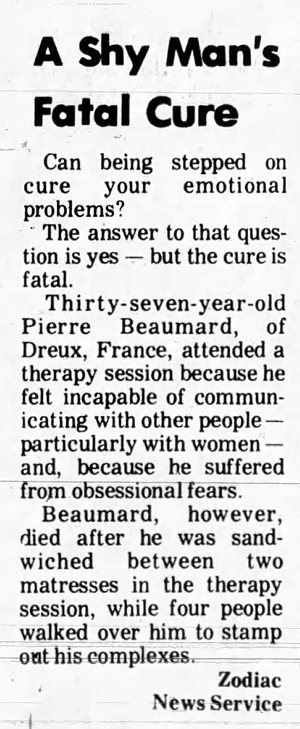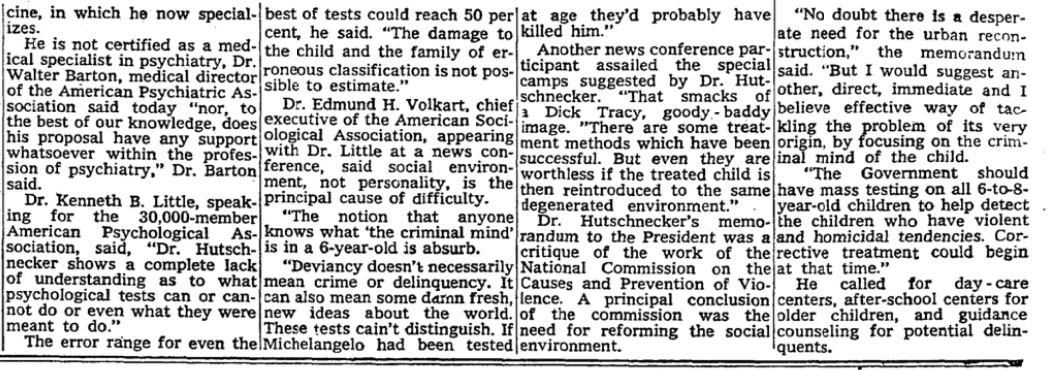Psychology
The Death of Pierre Beaumard
1979: To help cure his shyness around women, Pierre Beaumard's therapist had him lie sandwiched between two mattresses. This was meant to simulate the womb. Four people then walked on top of the mattresses to "stamp out his complexes". Beaumard died of suffocation.I'm skeptical about whether this story is true. For some reason it makes my BS spidey sense tingle. It was definitely reported in papers as legitimate news, but it's been known to happen that reporters will hear an urban legend or joke and then (knowingly or not) put it out on the wire services as a true story. I'm suspicious that's what happened here. I'd believe it more if I could find an original French source, which I can't.

The Santa Clarita Signal - May 27, 1979

The Ottawa Citizen - May 17, 1979
Posted By: Alex - Sun Sep 05, 2021 -
Comments (2)
Category: Death, Psychology, 1970s
Effective Emulation
A simple, psychological trick maximizes church giving:the evangelist knew that no person with money to give would be content with an "Amen" when a neighbor, sitting in the next pew, was acclaimed with a "Glory hallelujah!"

New York Times - May 18, 1919
Posted By: Alex - Wed Aug 18, 2021 -
Comments (3)
Category: Money, Religion, Psychology
Swindle’s Ghost
'Swindle's Ghost' is a term for an optical illusion that some psychologists have offered as a possible scientific explanation for ghost sightings. Actually, I doubt that many sightings are a result of this phenomenon, but I like the name.Newsday Special Correspondent Paul Brock (May 15, 1967) offered this explanation:
It can be summoned up by anybody. Using no more ectoplasm than a table lamp, friends can join you in this weird experiment, right in your own living room. Choose a dark moonless night and draw the drapes securely so that no stray light from street lamps or passing cars enters the room. Group the chairs near a table or floor lamp with one person directly alongside it to switch it on and off.
First, everyone must remain in the darkened room for at least 10 minutes before the experiment begins, so that the eyes can adjust completely to the darkness. Then, each ghosthunter must look steadily toward the lamp but not directly at it. They must keep perfectly still and keep the eyes from moving during the time the room will be illuminated and immediately afterward.
Now turn on the lamp for a full second. Turn it off. Shortly after you will see the whole scene loom up in the darkness with startling clarity, and the ghost impression will last for some time. Not only will everything appear exactly as it was when the light was on, but many precise details will be evident which could not possibly have been noted during the brief illumination...
The same optical illusion occurs when someone reports that he has seen a ghost in a graveyard at night. If a man is passing a graveyard at night and the moon breaks through the clouds just as he is opposite a white tombstone, in a few minutes he might see a vague white form loom up before him. The moon's illumination has created the 'ghost' which the man actually does see, but which is only an after-image— in the image of "Swindle's Ghost."
Some more info in the book Systems Theories and A Priori Aspects of Perception:
You can find Swindle's original article here:
Swindle, P.F. (1916). Positive Afterimages of long duration. American Journal of Psychology, 27, 325-334.
Posted By: Alex - Tue Jun 15, 2021 -
Comments (0)
Category: Paranormal, Supernatural, Occult, Paranormal, Psychology, Eyes and Vision
Arnold Hutschnecker’s Juvenile Criminality Tests
His Wikipedia page is here.Not mentioned is the legal charge at age 89 of seducing a patient.
Interesting details of his relationship with Richard Nixon in this obit.



Posted By: Paul - Sat Apr 24, 2021 -
Comments (0)
Category: Crime, Psychology, Children, 1970s
The man who thought he was a gopher
We've now posted about several cases of clinical zoanthropy, which is the belief that one has turned into an animal. There was the woman who thought she was a camel, and another woman who decided she was a chicken.Here's a third case, from 1982. Walter Murphy of Los Angeles, believing he was a gopher, started burrowing holes. PCP contributed to his delusion. He ended up suffocating to death inside one of his holes.

Kenosha News - Sep 21, 1982
Posted By: Alex - Tue Mar 09, 2021 -
Comments (1)
Category: Animals, Bad Habits, Neuroses and Psychoses, Psychology, 1980s
The Human Relationship Simulator
This post seemed appropriate for Valentine's Day, since it's about an engineer's attempt to use machine logic to improve the "ambiguities of the woman/man relationship".James F. Hollander was a patent attorney with a degree in electrical engineering. In the late 1970s he invented and patented what he called the "Human Relationship Simulator". It consisted of a box with various dials.
Even after reading his patent, and an article about his invention, I'm not exactly sure how the thing operated. From what I can gather, if a couple were having an argument, or needed to make a decision (such as where to go for dinner), they could both adjust dials on the Simulator, and it would give them an answer. And measure the intensity of their feelings.

Here's more info from a 1977 article in the Asbury Park Press:
Each subject uses dials that represent four areas — compliance with society, attention to own desire, social pressure and personal inclination. The personal inclination and social pressure gauges are intricately detailed to show adamant 'yes' or 'no' responses, or degrees such as strong preference, or very much or some.
Attention to desire is measured in readings of low, medium and high, as is compliance with society.
As the subjects feed this information into the panels, other gauges measure tension, feelings, guilt or pride, emotional independence, like and dislike, and influence, based on each decision.
The machine does the thinking, lights a decision of 'yes' or 'no' and tells the subjects their emotional responses....
In a marriage situation, Hollander said the device could show the individuals why something is going wrong in the relationship if arguments are portrayed and feelings defined.
"I wanted to pick out the ambiguities of the woman/man relationship," he pointed out.

Asbury Park Press - Aug 29, 1977
If that doesn't seem entirely clear, then here's a sample from Hollander's patent:
Posted By: Alex - Sun Feb 14, 2021 -
Comments (0)
Category: Technology, Patents, Psychology, Marriage, 1970s, Love & Romance
Index of Boredom
In 1957, advertiser John P. Cunningham came up with the concept of an "Index of Boredom" in an attempt to quantify how bored TV viewers were while watching shows. His research team studied 160 viewers in New Brunswick, NJ, and concluded that the most boring show on TV was Milton Berle, while the least boring show was "I Remember Mama".But they also came across an unexpected finding: people would continue to watch TV shows even if they found them boring.

Deseret News - Oct 29, 1957
Posted By: Alex - Sun Jan 31, 2021 -
Comments (3)
Category: Boredom, Television, Psychology, 1950s
Nude woman thought she was a camel
Assuming this woman was telling the truth, and she really thought she was a camel, then her case would be an example of the very rare condition known as clinical zoanthropy. That is, the belief that one has turned into an animal.We've posted about this condition before, in the case of the woman who thought she was a chicken.

Alabama Journal - Feb 27, 1976
I thought the woman might have been inspired by Joe Camel, but it turns out he was only introduced in 1987.

image source: Band of Artists
Posted By: Alex - Wed Dec 09, 2020 -
Comments (3)
Category: Animals, Psychology, 1970s
Cinematic Neurosis
Following the 1973 release of The Exorcist, six people who saw it had to be admitted to a Chicago hospital "straight from the theater." Psychiatrist James Bozzuto examined four of them and concluded they were suffering from "cinematic neurosis" — a term he coined. Basically, this was neurosis caused by watching a movie. Symptoms of this condition included "anxiety, helplessness, sleeplessness and repetitive post-traumatic dreams."
San Francisco Examiner - Dec 14, 1976
The 1975 release of Jaws also caused an outbreak of cinematic neurosis. Here's a description of a case from a December 1975 Knight News Wire article:
During these attacks, which always occurred at night, she appeared to be unaware of the world around her, and she didn't respond when people spoke to her.
Over the next three days, while doctors ruled out the possibility that she had meningitis or some other neurological problem, she had five of these attacks.
In between these episodes of terror, she talked with neurologist Arnold Barnett about her problem.
It seems that three days before admission, she had seen the motion picture "Jaws," movie history's biggest money-maker, which chronicles the bloody activities of a shark that terrorizes swimmers off the shores of Long Island.
Later that evening, after discussing the film with her friends, she became frightened and upset. She had her first attack the next day.
Barnett treated the girl with sedatives and reassuring conversation. He emphasized the unlikelihood of a shark attack in western Kansas.
Posted By: Alex - Tue Sep 22, 2020 -
Comments (1)
Category: Bad Habits, Neuroses and Psychoses, Movies, Psychology, 1970s
The woman who thought she was a chicken
A recent issue of the Dutch journal Tijdschrift voor Psychiatrie (Journal of Psychiatry) reports on the case of a woman who believed she was a chicken. From the report (via Google translate):Clinically, we saw a lady profusely sweating, trembling, blowing her cheeks and displaying stereotypical behavior in which she seemed to imitate a chicken, such as clucking, cackling and crowing like a rooster. After ten minutes, she seemed to tense the muscles for a few seconds, her face flushed and she did not respond for a short time. These symptoms repeated at intervals of several minutes, between which anamnesis was possible. The patient's consciousness was fluctuating, attention was hyper-reactive and the patient was disoriented in time and space. Her memory could not be tested objectively, but she could adequately tell her history.
She said she had barely slept since five days and wandered barefoot and dressed in a dressing gown on the street at around 4 a.m. the previous night. A general feeling of unwellness had been present for several days, as well as a strange feeling in the limbs, as if they no longer fit her body and flapped uncontrollably. The patient expressed the thought of being a chicken and that they had been forgotten to roost her.
Patient's brother added that he found her in the garden in the same condition as we saw her now. Between that moment and the registration with us, the bizarre behavior in attacks occurred.
The researchers note that clinical zoanthropy (the belief that one has turned into an animal) is an extremely rare delusion. Apparently there have been only 56 cases of this reported between 1850 and 2012. Some of the animals people believe they have become include "a dog, lion, tiger, hyena, shark, crocodile, frog, bovine, cat, goose, rhinoceros, rabbit, horse, snake, bird, wild boar, gerbil and a bee."
More info: The Guardian
Posted By: Alex - Tue Aug 04, 2020 -
Comments (13)
Category: Animals, Bad Habits, Neuroses and Psychoses, Psychology

| Who We Are |
|---|
| Alex Boese Alex is the creator and curator of the Museum of Hoaxes. He's also the author of various weird, non-fiction, science-themed books such as Elephants on Acid and Psychedelic Apes. Paul Di Filippo Paul has been paid to put weird ideas into fictional form for over thirty years, in his career as a noted science fiction writer. He has recently begun blogging on many curious topics with three fellow writers at The Inferior 4+1. Contact Us |




